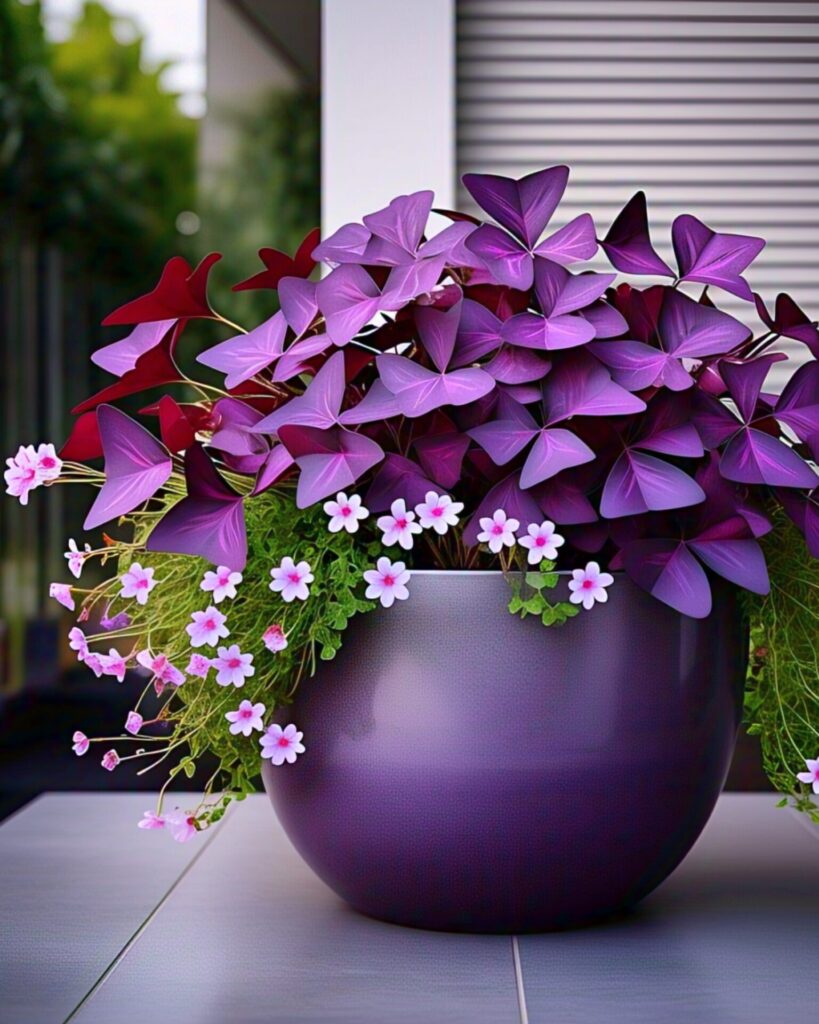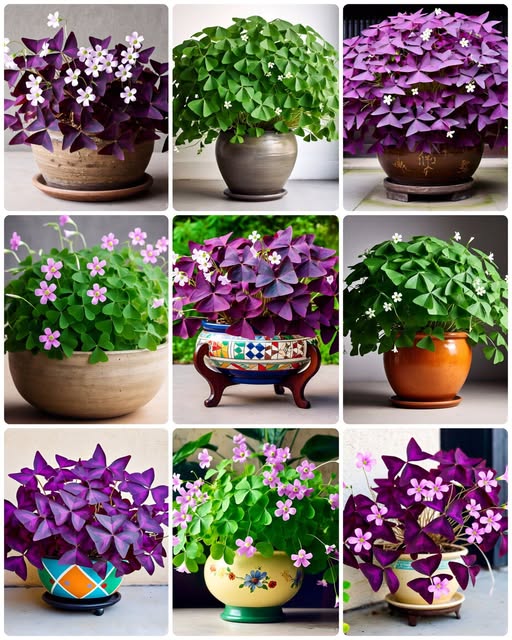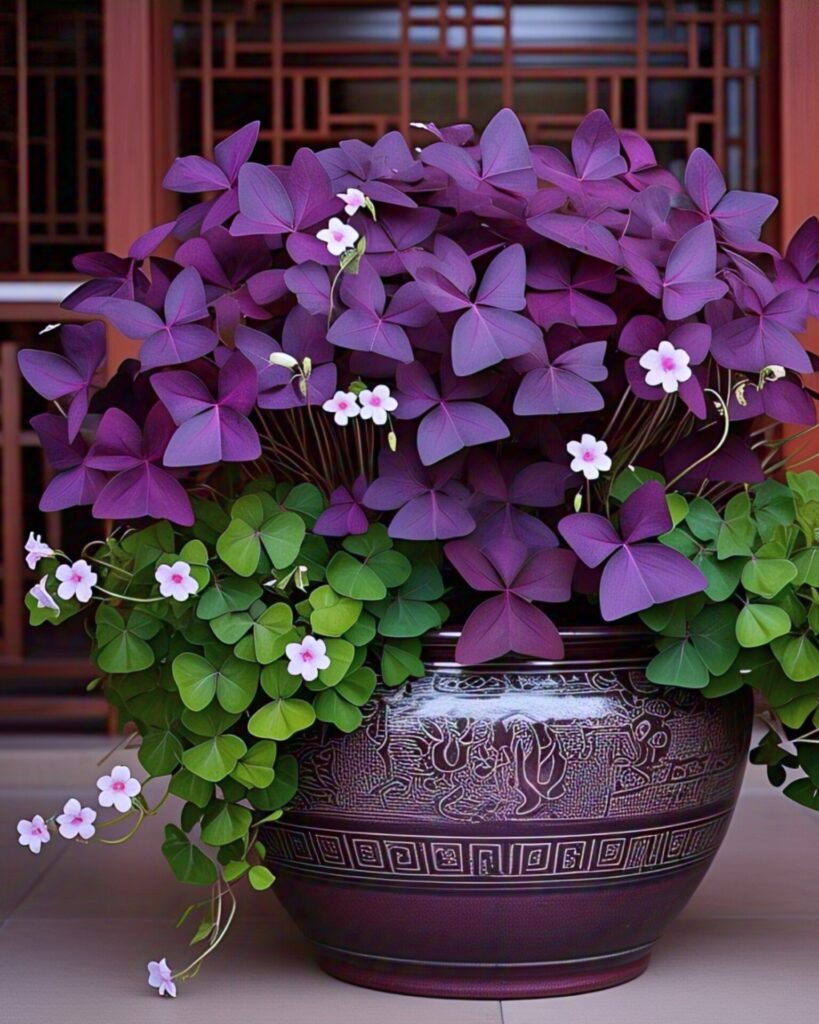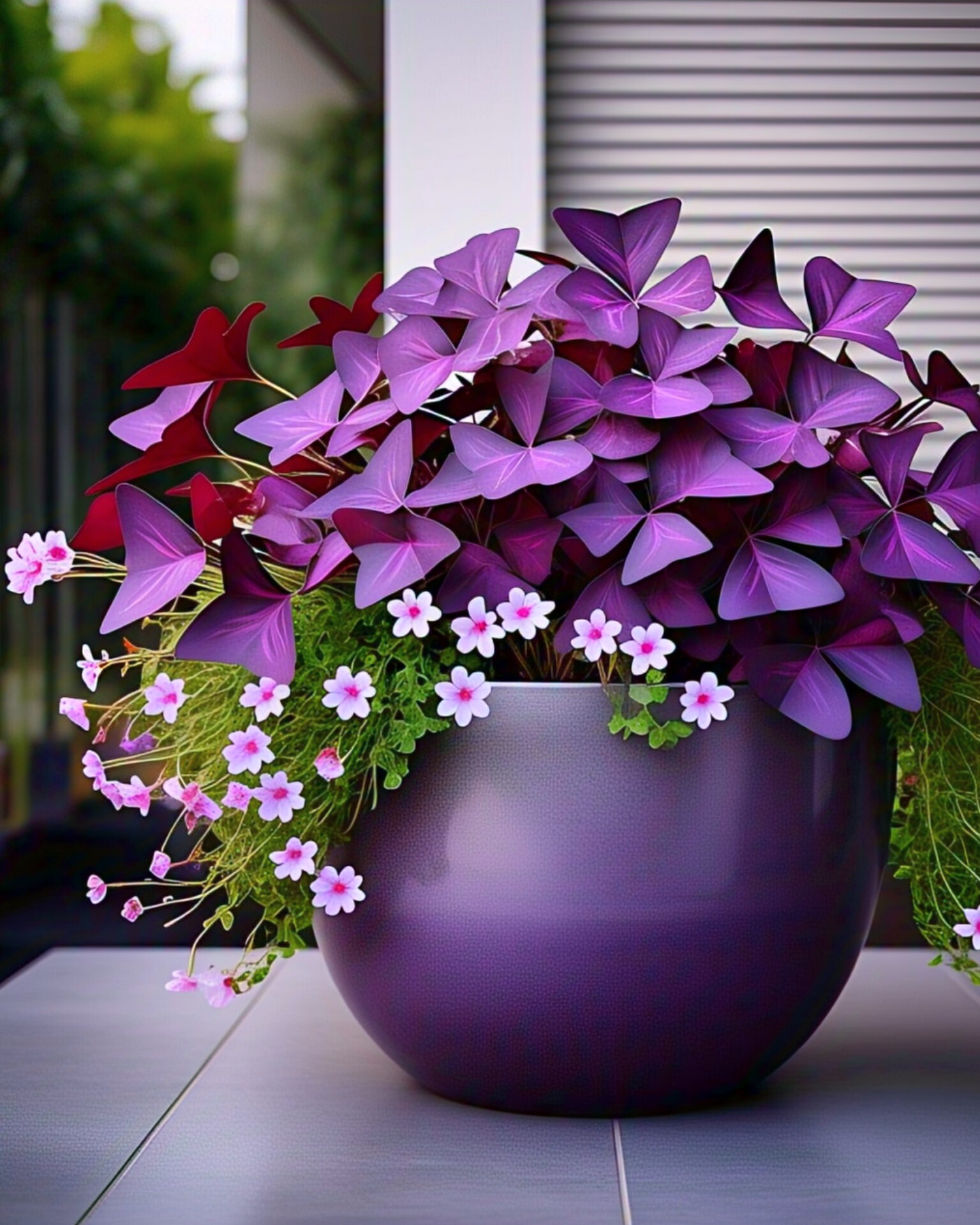If you’re searching for an oxalis triangularis plant for sale, you’re likely captivated by its unique beauty and charm. This fascinating houseplant, often known as the Purple Shamrock or Love Plant, is not just a simple addition to your home decor; it’s a vibrant piece of living art that invites admiration and conversation. As you embark on this journey to acquire one, you’ll discover not only the thrill of beautifying your space but also the deep connection that comes with nurturing such a remarkable plant.
Introduction to Oxalis Triangularis
The Oxalis triangularis is a standout member of the Oxalidaceae family, renowned for its distinctively shaped leaves and vivid coloration. Its elegant purple foliage, which resembles delicate triangles, transforms any interior space into a sanctuary of natural beauty. Its aesthetic appeal is complemented by an intriguing life cycle that includes phases of growth and dormancy, making it a captivating subject for both seasoned gardeners and novice plant lovers.

Overview of the Plant’s Characteristics
At first glance, the Oxalis triangularis mesmerizes with its lush, deep purple leaves that elegantly unfold like tiny sails. Each leaf boasts a unique trifoliate shape, reminiscent of a shamrock, which adds to its whimsical charm. The plant also produces small, delicate white or pink flowers that bloom at the tips of slender stems, creating a stunning contrast against the dark foliage.
Beyond its looks, the Oxalis triangularis is relatively easy to grow, which makes it ideal for those new to plant care. It thrives in well-drained soil and prefers indirect sunlight, making it suitable for various indoor settings, from cozy nooks to stylish workspaces. With proper care, this enchanting plant can live for several years, rewarding its caretaker with both visual delight and emotional fulfillment.
Historical Significance and Cultural Associations
The history of the Oxalis triangularis is rich and deeply intertwined with cultural symbolism. In many cultures, the shamrock represents luck and prosperity, often associated with Irish folklore. The common belief is that finding a four-leaf clover brings good fortune, and the Oxalis triangularis’ three-leafed structure has similarly been embraced as a symbol of hope and renewal.
In addition to its ties to luck, the plant has also appeared in various traditional medicines across the globe. Some cultures have valued its leaves for their nutritional content and medicinal properties, using them as herbal remedies for ailments ranging from digestive issues to inflammation. Thus, owning an Oxalis triangularis goes beyond mere decoration; it’s an embrace of cultural heritage and natural wellness.
The Unique Appeal of Oxalis Triangularis
What sets the Oxalis triangularis apart from other houseplants is its distinctive aesthetic and symbolic value. For anyone looking to enrich their home environment, this plant stands out as an exceptional choice.
Distinctive Leaf Structure and Coloration
Characterized by its striking purple hue, the leaves of the Oxalis triangularis are a masterpiece of nature. The triangular shape creates a dynamic visual effect, especially when the leaves shift and open toward the light, resembling a delicate dance. This movement is particularly mesmerizing during the day, as the leaves respond to the surrounding light conditions.
Moreover, the color of the leaves can vary based on environmental factors, adding another layer of intrigue. Under bright light, the purple may deepen, while in shadier spaces, the leaves may take on a softer hue. This adaptability allows the plant to harmonize beautifully within various interior design schemes, effortlessly elevating a room’s aesthetic.

Symbolism and Meaning in Different Cultures
In addition to its visual qualities, the Oxalis triangularis holds significant meaning in various cultures. Often viewed as a symbol of love and affection, it is sometimes gifted between friends and partners as a token of appreciation and goodwill.
Furthermore, its cyclical nature, marked by periods of dormancy, embodies the themes of rest and rejuvenation. This aspect resonates with many people, reminding them of the importance of balance in our busy lives. By bringing an Oxalis triangularis into your home, you become part of a larger narrative—one that honors the beauty of nature and its capacity for renewal and growth.
Benefits of Owning an Oxalis Triangularis
The decision to purchase an oxalis triangularis plant for sale is not solely about aesthetics; it’s also about the myriad benefits that come with caring for this remarkable plant.
Aesthetic Enhancement of Living Spaces
One of the primary reasons plant enthusiasts seek out the Oxalis triangularis is its unparalleled ability to enhance living spaces. When strategically placed, the plant can serve as a focal point, drawing attention and admiration from all who enter the room. The vivid purple hue complements various color palettes, making it a versatile choice for any interior design style, whether modern, rustic, or eclectic.
Additionally, due to its compact size, the Oxalis triangularis fits well on shelves, window sills, and tabletops without overwhelming the space. It adds a touch of serenity and whimsy, inviting moments of pause and reflection as one navigates through daily routines.
Therapeutic and Mindfulness Aspects of Care
Caring for an Oxalis triangularis offers more than just visual pleasure; it can foster mindfulness and therapeutic benefits. Engaging in plant care rituals, such as watering, pruning, and observing growth patterns, encourages individuals to slow down and connect with their surroundings.
This act of nurturing becomes a meditative practice, where one can reflect on the cycles of life mirrored in the plant’s growth. Just as the Oxalis responds to changes in light and water, so too can caretakers learn to be more attuned to their own needs for rest and revitalization. Thus, the Oxalis triangularis transcends being just a houseplant—it becomes a companion on the journey of self-discovery and personal well-being.
Understanding the Life Cycle of Oxalis Triangularis
To truly appreciate the Oxalis triangularis, one must understand its unique life cycle, which includes phases of growth and dormancy.
Growth Phases and Dormancy
Like many plants, the Oxalis triangularis experiences a rhythm of growth and rest. During its active growing season, typically in spring and summer, the plant flourishes, producing vibrant leaves and lovely blossoms. This period is characterized by rapid growth, requiring attentive care to ensure adequate moisture and light.
However, as the seasons change, particularly in late winter to early spring, the Oxalis will enter a dormant phase. This process can be startling for new owners, as the plant may lose some of its leaves. Understanding this cycle is crucial. It reflects the natural ebb and flow of life, offering a valuable lesson in patience and acceptance.

Nurturing Through Seasonal Changes
Caring for the Oxalis triangularis during its dormancy phase requires a gentle approach. Lowering water intake and providing indirect light helps the plant conserve energy, allowing it to thrive when reawakening in spring. This attentive approach fosters a deeper bond between the plant and its caretaker, encouraging a routine that embraces both growth and stillness.
Through this nurturing process, owners learn to appreciate the beauty of each phase, recognizing that every season contributes to the overall health and vitality of the plant. This cyclical relationship mirrors our own experiences, reminding us that growth often follows periods of reflection and rest.
Where to Buy Oxalis Triangularis
For those eager to find an oxalis triangularis plant for sale, there are numerous options available, whether locally or online.
Local Nurseries vs. Online Marketplaces
Local nurseries offer a hands-on experience, allowing potential buyers to inspect the plants in person. Here, you can observe the health of the Oxalis triangularis specimens, checking for vibrant leaves and robust roots. Establishments such as these often provide valuable advice and recommendations tailored to your specific growing conditions.
On the other hand, online marketplaces present a broader selection. Whether you’re looking for standard varieties or rare cultivars, the internet serves as a treasure trove for plant enthusiasts. However, purchasing online requires discernment, as the quality of plants can vary significantly between sellers.
Tips for Finding Healthy Specimens
When seeking an oxalis triangularis plant for sale, consider the following tips to ensure you select a healthy specimen:
- Observe the Foliage: Healthy leaves should appear vibrant and devoid of spots or discoloration. Curled or yellowing leaves signal distress.
- Check Root Health: If possible, inspect the roots. They should be firm and white, indicating a healthy plant. Softer, brown roots indicate rot or disease.
- Seller Reputation: Research seller ratings and customer feedback to gauge the reliability of your source. Positive reviews and testimonials can guide you toward reputable vendors.
By taking these steps, you can ensure that your investment in an Oxalis triangularis will flourish in your care, enriching your home with its distinctive beauty.
Evaluating Quality When Purchasing
Understanding how to evaluate the quality of an oxalis triangularis plant for sale is essential in ensuring long-term satisfaction.
Recognizing Healthy Plants
A healthy Oxalis triangularis should have firm, vibrant leaves free from pests and diseases. Any signs of wilting, discolored foliage, or pests can be red flags indicating underlying issues. Moreover, the potting medium should be fresh and drain well, allowing for optimal root health.
Additionally, check for signs of new growth, such as young leaves emerging. This signifies that the plant is healthy and ready to adapt to its new environment.
Importance of Seller Ratings and Reviews
Before finalizing your purchase, it’s wise to read seller ratings and reviews. Feedback from previous customers can provide insights into the quality of plants and the service provided. Look for sellers who specialize in houseplants and maintain high standards for their inventory.
An established reputation for delivering healthy, well-packaged plants demonstrates a commitment to customer satisfaction and plant health. This research can prevent disappointments and ensure you receive a thriving Oxalis triangularis to cherish.
Care Requirements for Oxalis Triangularis
Once you’ve acquired your oxalis triangularis, understanding its care requirements is vital for maintaining its health and vibrancy.
Ideal Lighting Conditions
The Oxalis triangularis thrives in bright, indirect light. Direct sunlight can scorch its delicate leaves, leading to damage and stress. Placing it near a north or east-facing window provides ample light without harsh rays.

Monitor your plant’s response to its environment. If you notice stretching towards the light, it may indicate insufficient exposure. Conversely, if the leaves begin to fade or show signs of distress, adjusting their position can quickly alleviate stress.
Watering and Soil Preferences
Maintaining a consistent watering schedule is crucial for the Oxalis triangularis. The soil should be kept moderately moist, allowing the top inch to dry out before watering again. Overwatering can lead to root rot, while underwatering can cause leaf drop and dormancy.
Using a well-draining potting mix, such as a blend of peat moss, perlite, and compost, ensures optimal drainage and aeration. This foundation supports healthy root development and provides the necessary nutrients for growth.
Fertilization and Nutrient Needs
Just as understanding light and water is critical, comprehending the fertilization needs of the Oxalis triangularis helps keep it thriving.
Best Practices for Feeding Oxalis Triangularis
During its active growing season, typically from spring to summer, the Oxalis triangularis benefits from regular fertilization. A balanced liquid fertilizer diluted to half strength every 4-6 weeks promotes healthy growth and vibrant foliage.
In the dormant phase, reduce feeding to allow the plant to conserve energy. Avoid fertilizing during this period to prevent nutrient buildup in the soil, which could harm the roots.
Recognizing Signs of Nutrient Deficiency
A well-cared-for Oxalis triangularis displays lush growth, but various deficiencies can manifest if nutrient levels dwindle. Yellowing leaves may indicate nitrogen deficiency, while stunted growth suggests a lack of essential minerals. By monitoring your plant closely, adjustments can be made promptly to restore its health.
Regularly inspecting your plant and adapting your fertilization strategy ensures that your Oxalis triangularis remains a dazzling centerpiece in your home.
Common Pests and Diseases
As with many houseplants, the Oxalis triangularis may fall victim to pests and diseases, necessitating vigilance on the part of its caretaker.
Identifying Potential Threats
Common pests affecting the Oxalis triangularis include aphids, mealybugs, and spider mites. These tiny intruders often appear on the undersides of leaves or along stem joints, sucking sap and weakening the plant over time.
Recognizing the early signs of infestation is key to preventing severe damage. Look for discolored patches, webbing, or sticky residue on the leaves and act swiftly to eradicate the problem.
Preventive Measures and Treatment Options
Preventative measures are crucial in safeguarding your Oxalis triangularis. Maintaining proper humidity levels and air circulation minimizes the likelihood of pest infestations. Regularly wiping down leaves removes dust and creates an inhospitable environment for pests.
If an infestation occurs, treating with insecticidal soap or neem oil can effectively manage the situation. Always test a small area first to ensure no adverse reactions occur. Consistent monitoring and treatment promote a healthy and pest-free environment for your beloved plant.
Propagation Methods for Oxalis Triangularis
For those interested in expanding their collection or sharing the beauty of the Oxalis triangularis, propagation is a rewarding endeavor.
Division Techniques
Dividing the plant is one of the easiest methods of propagation. When the Oxalis triangularis grows large enough, it can be separated into smaller sections, each with its roots and foliage.
Choose a healthy plant and carefully remove it from its pot. Gently separate the root ball into multiple sections, ensuring each section retains some healthy leaves and roots. Replant the divisions in fresh soil, water them well, and place them in an appropriate light setting.
Growing from Seeds
Alternatively, growing Oxalis triangularis from seeds presents a more intricate option. Collect seeds from the plant after flowering, allowing them to dry thoroughly before planting.
Start seeds indoors in sterile potting soil, lightly covering them with a thin layer of soil. Maintain consistent moisture and warmth until seedlings emerge. This process requires patience, as germination can take several weeks. However, the joy of bringing new plants to life is well worth the wait.
Display Ideas for Oxalis Triangularis
Once established, the Oxalis triangularis deserves a prominent place in your home, showcasing its beauty and uniqueness.
Creative Potting Solutions
Selecting the right pot can enhance the aesthetic appeal of your Oxalis triangularis. Opt for pots that complement its vibrant colors—a sleek white pot or a textured ceramic container can create striking contrasts, accentuating the plant’s allure. Additionally, consider utilizing terrariums, hanging baskets, or tiered plant stands to create visual interest in your space.
Integrating with Other Houseplants
Oxalis triangularis can be beautifully partnered with other houseplants, enhancing the visual tapestry of your indoor garden. Pair it with plants that share similar care requirements, such as ferns or peace lilies, to create a lush, verdant oasis.
Experiment with various arrangements, contrasting textures and colors to create a harmonious display. The interplay of different species adds depth and dimension to your gardening efforts, inviting closer examination and admiration.
Oxalis Triangularis Varieties and Cultivars
As you delve deeper into the world of Oxalis triangularis, you’ll discover a range of cultivars and related species that may pique your interest.
Popular Cultivars in the Market
Among the most sought-after cultivars is the traditional variant of Oxalis triangularis, celebrated for its striking purple foliage. However, enthusiasts can also find other stunning varieties, including those with variegated leaves or differing blossom colors, providing an array of choices to suit personal preferences.
These cultivars bring diversity to collections, allowing plant lovers to explore the nuances of each type while enriching their gardening experience.
Rare Finds for Enthusiasts
For avid collectors, seeking out rare Oxalis triangularis varieties can be an exhilarating pursuit. Specialty nurseries and plant swaps often feature hard-to-find cultivars that add exclusivity to collections.
Participating in online forums and plant exchange groups fosters connections with fellow enthusiasts, increasing the chances of discovering rare gems. Sharing knowledge and resources within the community enhances personal growth, turning the journey of plant collecting into a collaborative adventure.
Troubleshooting Common Issues
Even the most dedicated caretakers may encounter challenges while nurturing an Oxalis triangularis. Recognizing and addressing common issues can help maintain its health and beauty.
Addressing Leaf Yellowing and Dropping
Yellowing leaves may indicate improper watering practices or inadequate light conditions. Evaluate your care routine, adjusting watering schedules and light exposure as needed. Remember, the Oxalis triangularis prefers consistency; fluctuations in care can lead to stress.
If the plant drops leaves unexpectedly, check for pests and assess the environmental factors. Creating a stable environment promotes resilience and prevents further complications.
Managing Overwatering and Root Rot
Overwatering is a prevalent issue among houseplant enthusiasts. Signs of root rot include mushy roots, a foul odor from the soil, and wilting leaves despite sufficient moisture. To rectify this, immediately reduce watering and allow the soil to dry out before resuming care.
In cases of severe root rot, repotting the plant into fresh, well-draining soil may be necessary. Trim away any affected roots before replanting, ensuring the Oxalis triangularis has the best chance for recovery.
Environmental Factors Affecting Growth
The environment in which your Oxalis triangularis resides significantly influences its health and growth.
Temperature and Humidity Considerations
Optimal temperatures for the Oxalis triangularis range from 60°F to 75°F, making it a comfortable fit for most indoor environments. Extreme temperature fluctuations can stress the plant, so placing it in stable conditions is essential.
Humidity also plays a role in the plant’s well-being. While it adapts well to average household humidity, occasionally misting the leaves can enhance its vibrancy and health, especially during the dryer months.
The Role of Air Circulation
Adequate air circulation is essential for preventing fungal diseases and promoting healthy growth. Ensure the Oxalis triangularis has room to breathe, avoiding overly crowded arrangements.
Moving the plant periodically or rotating it can enhance its exposure to fresh air, invigorating its leaves and supporting overall vitality.
The Role of Oxalis Triangularis in Indoor Air Quality
One of the lesser-known benefits of the Oxalis triangularis is its contribution to indoor air quality.
Contribution to Air Purification
Like many houseplants, the Oxalis triangularis aids in improving air quality by filtering harmful toxins and pollutants. Its ability to absorb carbon dioxide and release oxygen contributes to a healthier living environment, facilitating better respiratory function for its inhabitants.
Integrating this plant into your home not only beautifies your space but actively supports well-being, creating a nurturing atmosphere conducive to relaxation and productivity.
Creating a Healthier Living Space
By incorporating the Oxalis triangularis alongside other air-purifying plants, you can cultivate a sanctuary that uplifts the spirit and nurtures your physical health. As you create green corners in your home, consider pairing it with recognized air-purifying species like snake plants and pothos for maximum impact.
The combination of vibrant greenery and improved air quality enhances your living space, transforming it into a haven of tranquility and vitality.
Personal Reflection and Connection with Your Plant
The journey of nurturing an Oxalis triangularis extends beyond mere plant care; it involves fostering a meaningful connection with nature.
Building a Routine Around Plant Care
Establishing a consistent care routine helps build a profound relationship with your Oxalis triangularis. Dedicating time each week to tend to its needs reinforces the importance of mindfulness in everyday life.
Engaging with the plant—whether by watering, pruning, or simply observing its growth—becomes a cherished ritual. These moments allow for reflection and gratitude, creating a bond that transcends the ordinary.
The Meditative Aspects of Nurturing Nature
Caring for an Oxalis triangularis can provide a sense of calm amidst life’s chaos. Taking time to nurture a living being fosters a deeper appreciation for nature and its complexities.
This meditative practice allows you to center yourself, focusing on the present moment and the rhythms of life. In turn, this mindfulness can spill over into other aspects of your life, enhancing overall well-being.
Conclusion: Bringing Home Oxalis Triangularis
Ultimately, the decision to bring an oxalis triangularis plant for sale into your home represents much more than merely acquiring a beautiful piece of nature. It embodies a commitment to personal growth, mindfulness, and the celebration of life’s cycles.
As you navigate the journey of selecting, caring for, and nurturing your Oxalis triangularis, may you find joy in every phase, transforming your relationship with nature into a profound source of inspiration. Whether you’re drawn to its captivating beauty, its cultural significance, or its contributions to air quality, the Oxalis triangularis enriches your life in countless ways. Embrace the adventure of plant care, and allow the vibrant energy of the Oxalis triangularis to flourish in your home and heart. Back Viết tiếpNext










